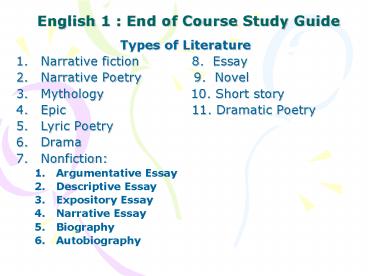English 1 : End of Course Study Guide PowerPoint PPT Presentation
1 / 9
Title: English 1 : End of Course Study Guide
1
English 1 End of Course Study Guide
- Types of Literature
- Narrative fiction 8. Essay
- Narrative Poetry 9. Novel
- Mythology 10. Short story
- Epic 11. Dramatic
Poetry - Lyric Poetry
- Drama
- Nonfiction
- Argumentative Essay
- Descriptive Essay
- Expository Essay
- Narrative Essay
- Biography
- Autobiography
2
Elements of Literature EOC pg 2
- Plot
- Conflict
- Climax
- Protagonist
- Antagonist
- Secondary Characters
- Setting
- Theme
- Point-of View
- Mood
- Tone
- Characterization
- Subplot
3
Literature Terms and Techniques-EOC Study Guide,
page 3
- Simile
- Metaphor
- Personification
- Hyperbole
- Rhythm
- Assonance
- Alliteration
- Prose
- Dialogue
- Stage directions
- Tragedy
- Comedy
- Dramatic Irony
- Foreshadowing
- Onomatopoeia
- Rhyme
4
Literature Terms-EOC study guide, page 4
- 17. Imagery 34.
Epithet - Stanza 35. Blank
Verse - Repetition 36.
Dramatic Foil - Sonnet 37.
Monologue - Ballad 38.
Flashback - Free Verse 39. Aside
- Denotation 40. Prologue
- Connotative 41. Tragic
Flaw - Literal 42. Main
Idea - Irony 43.
Details - Symbol 44.
Comparison - Archetype 45.
Contrast - Homeric Simile 46.
Situational Irony - Figurative Language 47. Characters
- Epic Hero a.
flat - Epic Couplet b.
round - Couplet c.
static -
d. dynamic
5
EOC Study Guide, page 5
- 48. Allusion 65.
Pun - 49. Satire
66. Fact / opinion - 50. Historical Fiction 67. Propaganda
- 51. General / specific 68.
Optimistic - 52. Point / counterpoint 69.
Pessimistic - 53. Bias
70. Soliloquy - 54. Extended Metaphor 71.
Diction - 55. Parody
72. Memoirs - 56. Oxymoron 73.
Rhyme Scheme - 57. Stereotype 74.
Foil - 58. Inference
- 59. Complication
- 60. Cause
- 61. Effect
- 62. Simplistic vs./ complex
- 63. Conservative vs./ creative
- 64. caricature
6
EOC Study Guide, page 6
- Recognize and Recall
- Recognize Main Idea
- Recognize major details
- Identify sequence of selection
- Recognize comparison
- Recognize contrast
- Characterization
- Draw logical inferences and conclusions from a
selection - Edit for grammar and language conventions
- Edit for complete sentences
- Edit for correct capitalization
- Edit for correct punctuation () (,) () ()
- Edit for correct spelling
- Edit for Word Usage
- Edit for proper format sequence of a passage or
passages
7
EOC Study Guide, page 7
- Punctuation
- Colons
- Use to introduce a list (statement must be
concluded then write the list). Ex. Noted
American aviators include these Wiley Post,
Charles Lindbergh, and Amelia Earhart. - Use a colon before a formal quotation. Ex.
Winston Churchill said this about public
speaking If you have an important point to
make, dont try to be subtle or clever.. - Use a colon in time, (125) verse, (Job 6 1-8)
Business letter, (Sir or Madam). - Semicolon
- Use to separate two main clauses (sentences) that
do not use a conjunction. - Ex. She cant play the drums I know she would
like to learn.
8
EOC Study Guide, page 8
- Use a semicolon when you have a list of things
using commas. . Ex. Hawaiian words familiar to
many mainlanders include luau, which means
feast aloha, which can mean love, welcome,
or farewell and hula, which means dance. - 3. Use to separate two main clauses joined by a
coordinating conjunction (but, so, for, and) when
such clauses already contain several commas. Ex.
Travel ads often focus on Oahus attractions,
such as Waikiki Beach, Pearl Harbor, and Diamond
Head but the state has many other interesting
sites. - 4. Use a semicolon to separate main clauses
joined by a conjunctive adverb or by an
expression such as for example or that is. Ex.
There are 132 Hawaiian island however, nearly
all residents live on seven of the islands.
9
EOC Study Guide, page 9
- Commas
- Use between two main clauses with a conjunction
but, and, so, for, nor, yet. Ex. I recognize
her, but I cant think of her name. - 2. Use commas to separate a series of things.
- Ex. drinks, cups, and ice. Ex. Ayala is a
member of the Debaters Club, the Glee Club, and
the swimming team. - --Use to separate extra word. Ex. Waving, the
flag showed her colors. Ex. My brother, Bob,
came home yesterday. - --After a prepositional phrase. Ex. During the
final minutes of the game, the crowd cheered
wildly. - Comma in titles, (Name, M.D.) addresses,
(Lumberton, NC) and numbers, (May 20, 2006). - Use between coordinate modifiers. Ex. She is a
smart, athletic student. - 6. Underline big things (ex magazines, Time) and
(ex articles in a magazine Our Schools
Today).

